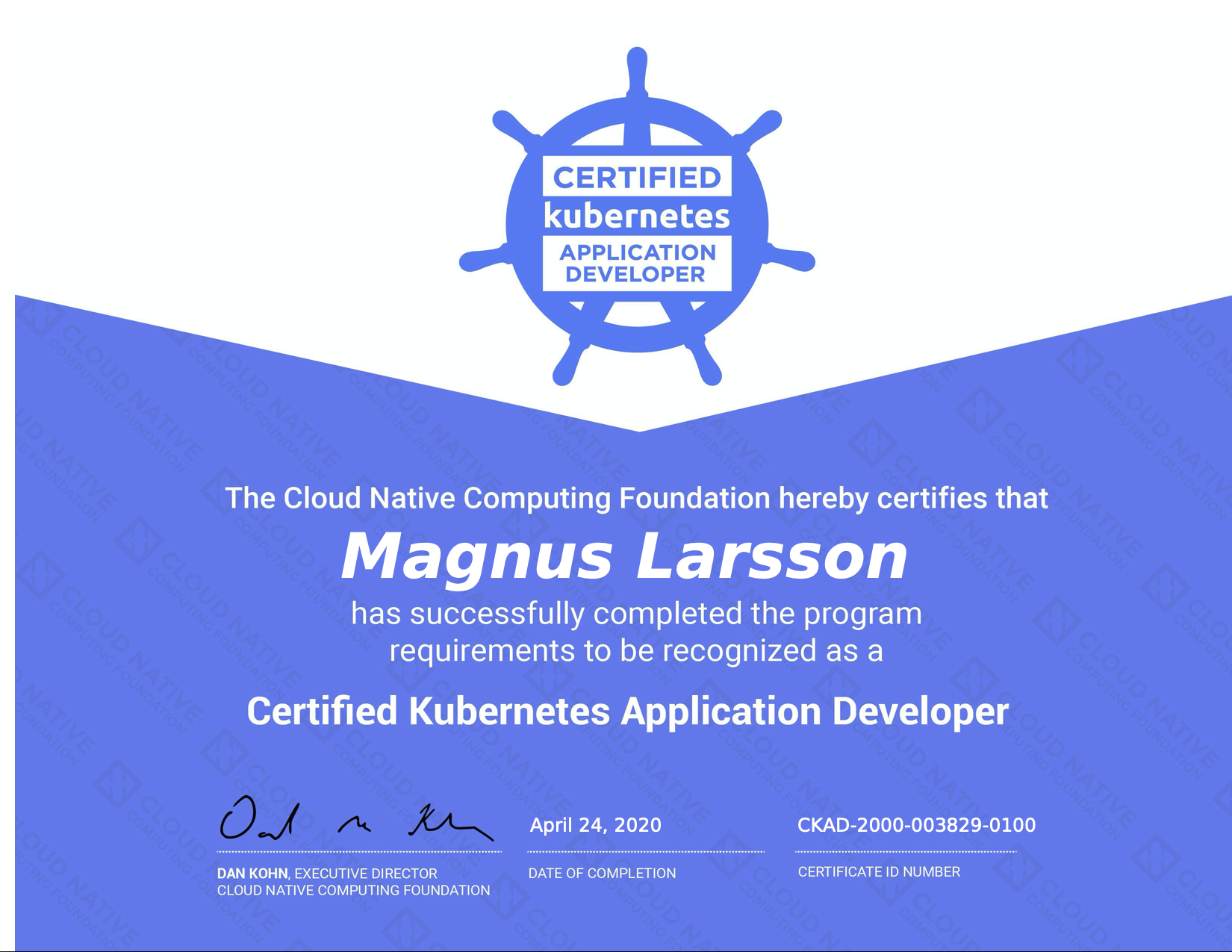Blogg
Här finns tekniska artiklar, presentationer och nyheter om arkitektur och systemutveckling. Håll dig uppdaterad, följ oss på LinkedIn
Här finns tekniska artiklar, presentationer och nyheter om arkitektur och systemutveckling. Håll dig uppdaterad, följ oss på LinkedIn

Last week I passed the CKAD exam (Certified Kubernetes Application Developer). In this blog post, I will share some preparations I did to be able to solve the tasks in the exam, specifically on how I prepared for the time constraints in the exam.
I have been working with Kubernetes since its inception in 2014, and I decided recently to manifest my experience by taking the CKAD exam.
The CKAD exam in summary:
From reading the exam curriculum, I realized that I was used to most of the concepts but lacked experience from using a few of them. So I browsed through an on-line course to catch up on the missing parts. Being rather self-confident, I started to go through the tests at the end of the course. I then realized that even if I had experiences from using most of the concepts in the exam, I was not fast enough to execute the exercises given the time available. It took me too long time to use kubectl and vi, i.e. the main tools used during the exam.
I guess you can use any text editor available in the Linux terminal, but
viwas the one I had some previous experience with.
So I had to practice a lot to be fast enough to pass the exam!
Many of the exam tasks can be solved by using the following steps:
Creating a yaml file containing start material for the task
Use kubectl imperative commands, e.g. run and create with the options --dry-run -o yaml > n.yaml to create the yaml file (not yet creating the corresponding resource in the Kubernetes cluster).
Adding the final parts to the yaml file using an editor like vi
The required syntax for the missing pieces can be found in either the links listed above or by using the kubectl explain command.
Create the Kubernetes resources
Use the kubectl apply -f n.yaml command to create the resources in the Kubernetes cluster.
Verify the expected result
Use kubectl commands get -o yaml, describe, exec, and logs to verify that you got the expected result.
Sometimes a HTTP endpoint inside the Kubernetes cluster needs to be verified. This can be done using either kubectl port-forward and a local curl command in the Linux terminal or by launching a Kubernetes pod that can run the curl command inside the cluster, e.g.:
kubectl run –image=curlimages/curl –restart=Never -i –rm curl-pod – curl $service:$port -s -m1
To be able to solve the tasks in the exam fast enough, I recommend the following preparation steps:
Take a course to ensure that you learn all parts of Kubernetes required for the exam.
I suggest the course Kubernetes Certified Application Developer (CKAD) with Tests provided by KodeKloud at Udemy.
Read through all material available at CKAD Certification Exam Candidate Resources, i.e. the Candidate Handbook, Exam Tips, and FAQ
Bookmark favorite links to the Kubernetes documentation.
You are allowed to use bookmarks in Chrome to your favorite pages in the links listed above. Get used to use these bookmarks when looking up information.
Setup alias and autocomplete according to kubectl-autocomplete. Use it both when you practice and during the exam!
Using k as shorthand alias for kubectl and enabling autocomplete for kubectl commands will save you a lot of time!
Set up a bookmark in Chrome to this link!
Practice on all options available for the imperative kubectl commands for creating start material for the yaml files. Specifically the kubectl run command contains a lot of useful options for creating a Pod, e.g. --labels, --limits, --port, --requests, --serviceaccount, and -- [COMMAND] [args...].
The CKAD environment has recently been upgraded to Kubernetes v1.18, where deprecated variants of the kubectl run command have been removed. This means that the run command only can be used to create Pods and that the create command has to be used to create Deployments, Jobs, and CronJobs.
If you still want to use all the useful options in the run command for a Pod when creating a Deployment, you have to execute both the run command and the create deployment command. Next, you need to paste the result from the run command into the result of the create deployment command. The content under the template: section shall be replace with the metadata: and spec: sections from the run command. Don’t forget to indent the output from the run command correctly (i.e. using 4 spaces). Practice, practice, practice…
kubectl commands:
label, annotate, expose, and set can be useful for some taskskubectl rollout command.--show-labels option of the kubectl get command.kubectl get ... -o yaml > n.yaml command to get started.Learn how to configure vi to edit yaml files efficiently.
My recommendation is to create a .vimrc file in the home folder with the command vi ~/.vimrc and enter:
set number
set tabstop=2 shiftwidth=2 expandtab
Explanations to the configuration:
set number makes vi show line numbers, very handy if kubectl complains about an error on a specific line in a yaml file.set tabstop=2 shiftwidth=2 expandtab makes vi expand TAB characters to two spaces and sets indentation to two characters, perfect when editing yaml files.vi keystrokes to manipulate yaml files, specifically:
Once you feel confident with the tests provided by the course you took, I recommend that you sign up for the CKAD Simulator provided by killer.sh.
It provides you with an environment similar to the exam environment. When you sign up, you are allowed to run the tests in two separates sessions. If you don’t feel confident after the first test session, go back and practice on the tasks in the course or look for additional examples on the Internet. Hopefully, you feel confident after taking the second test in the CKAD simulator and are ready for the real exam!
During the exam, keep calm and work focused on one task at the time. Always ensure you are on the right cluster and in the right namespace before you start to work on a new task. If you get stuck on a task, you can flag it as unfinished and move on to the next task. If you have time left after going through all tasks, you can go back to unfinished tasks and work on them.
Using these preparations, I was able to be fast enough with kubectl and vi to work through all 19 exercises and got a score of 97%, see my certification badge and:

Good luck with your preparations and the CKAD exam!